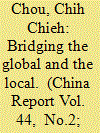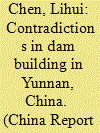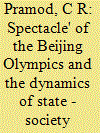| Srl | Item |
| 1 |
ID:
085415


|
|
|
|
|
| Publication |
2008.
|
| Summary/Abstract |
This article aims to explore China's attempt to shift the tension between the global value and local difference over human rights debates. In other words, this article examines the relationship between West-promoted human rights and China-led neo-Confucian values within the context of globalisation rather than examining what Confucian values are. In what ways can a cultural discourse be viewed and employed to promote human rights without denying their universality, is the focal point of this article. This article: (a) reviews why universalist versus relativist is a false dichotomy; (b) introduces the reconstruction of Confucianism since the 1980s in China and examines the possibility of re-appropriating Confucian values; (c) elaborates the necessity of nation-states for resisting the threats of globalisation and for implementing human rights practices; and (d) concludes with Confucian discourse, developed in China, as an exemplary case that universal values and particular differences can be negotiated in a way that respecting cultural differences constitutes a universal value.
|
|
|
|
|
|
|
|
|
|
|
|
|
|
|
|
| 2 |
ID:
085411


|
|
|
|
|
| Publication |
2008.
|
| Summary/Abstract |
When choosing the site of a dam, meeting the needs of the resettled local communities should be a key criterion in making any decision to build a dam. On the basis of a pilot study in Yunnan, China, this article finds that neither displacement into the area surrounding the dam nor movement to other towns, can meet the needs of the communities displaced by dams. This is because: (a) ideal areas for dam building often do not coincide with the factors necessary to restore the economy of the resettlement communities; and (b) cultural diversity exacerbates the impacts of displacement by a dam. It is concluded that overcoming the limitations of the contradictions between dam construction and resettlement is difficult. More work is needed on the resettlements in Yunnan. The cultural dimensions should be taken into consideration before further decisions on dam building and resettlement are made.
|
|
|
|
|
|
|
|
|
|
|
|
|
|
|
|
| 3 |
ID:
085413


|
|
|
|
|
| Publication |
2008.
|
| Summary/Abstract |
The preparations for the 2008 Beijing Olympics can be analysed to reveal the changing nature of the state, society and market forces and their mutual interaction in the People's Republic of China (PRC). It is also useful in understanding the consensual aspect of the Chinese state. Examining how the Beijing Olympics is being organised as a spectacle is important in understanding how Chinese state power has developed and maintained its consensus vis-É-vis the society in the post-Mao period. This process of institutionalisation of state, society and market interactions in the field of sport could provide insights regarding parallel developments in other sectors as well in China today.
|
|
|
|
|
|
|
|
|
|
|
|
|
|
|
|
| 4 |
ID:
085416


|
|
|
|
|
| Publication |
2008.
|
| Summary/Abstract |
Technology transfer in Sino-Japanese relations assumes immense significance given the increasing role of technology in the developmental trajectory of the international, regional and their respective domestic contexts. What is singularly distinct about the technology transfer process is that it is punctuated by two contrasting phenomena of conflict and cooperation. Of these two, cooperation dominated until the 1980s, so long as the Chinese technological capabilities were still in the process of maturation. Once China began its journey on the path of becoming a technological superpower in the 1990s, conflict entered the technology transfer architecture between the two.
|
|
|
|
|
|
|
|
|
|
|
|
|
|
|
|